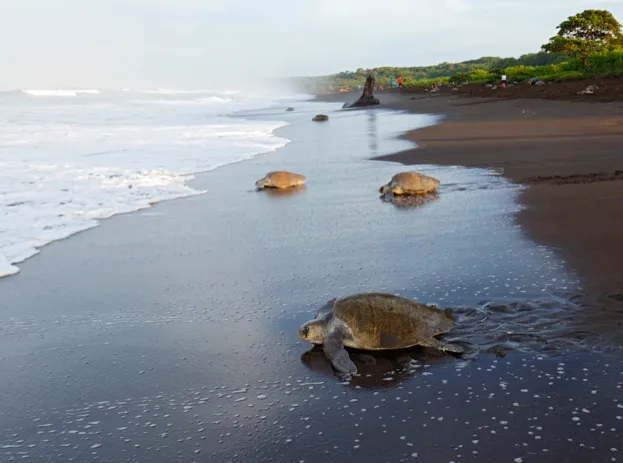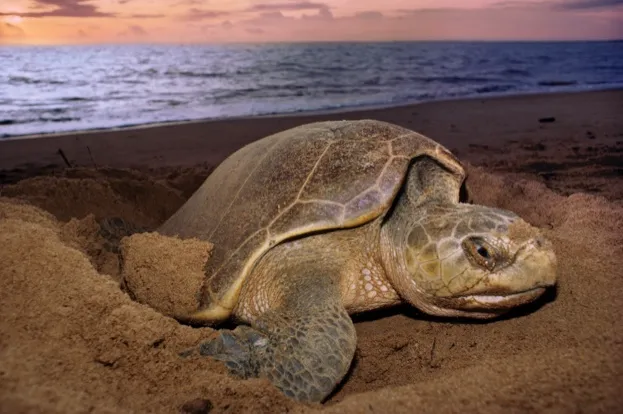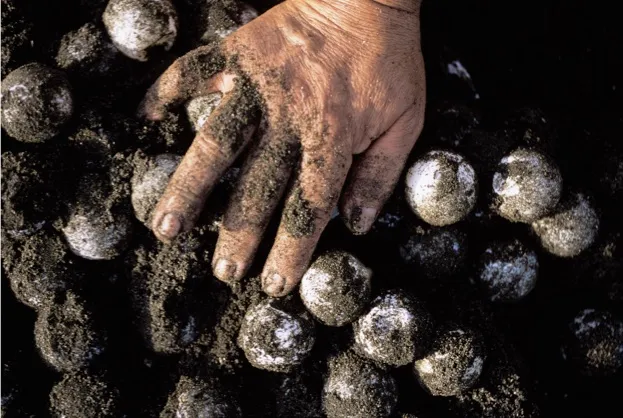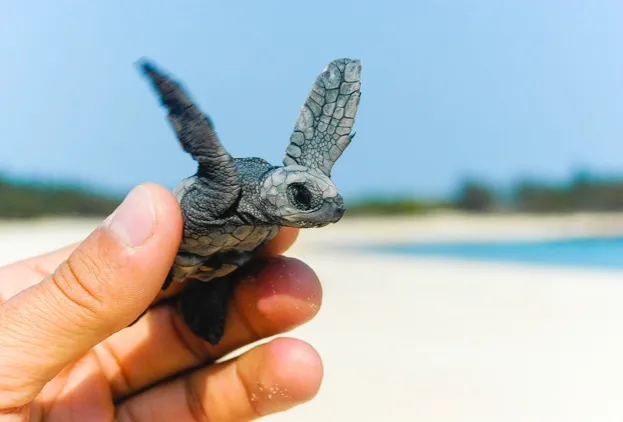Female olive ridley turtles arrive on a beach to lay their eggs © Jeff Rotman / Getty
It’s early on a perfect morning and I am sitting alone on a deserted beach in north-west Costa Rica. In front of me dawn picks out the wave crests on the vast, restless expanse of the Pacific, painting them pink. The Nicoya Peninsula is a surfers’ paradise, but I have not come here to surf.
I have planned my visit to Playa Ostional carefully. It is high tide during the last quarter of the moon in November – the ideal time, I am told, to experience one of the greatest natural spectacles this planet has to offer. I am waiting patiently, just as I did yesterday morning and the morning before that.
On those days I left disappointed, but now I can see something in the waves. A dark shape appears briefly, then sinks out of sight. Finally, it reveals itself in the shallows: a turtle.
I am witnessing the arrival of an egg-bearing female olive ridley, a magnificent 60kg reptile about to bury her precious treasure in the black sand. I have seen similar scenes, involving different species of turtle, many times before.
The intimacy and solemnity of the encounters are always profoundly moving. But today is different: the ‘togetherness’ of me and the mother turtle is disturbed by a second olive ridley. And then a third, a fourth, a fifth… until the beach is covered with turtles.

Olive ridley turtles on a beach in Costa Rica © Juan Carlos Vindas / Getty
Waves of turtles
This is what Costa Ricans call an arribada, the Spanish for ‘arrival from the sea’. More and more turtles are advancing towards me now, while the first ones ashore are busy digging, flinging sand to either side of their bodies.
Soon there are so many turtles that I can’t help feeling utterly insignificant, not least because some of them have probably been on this planet longer than my 38 years.
It is difficult to focus on a single female, but I settle on one and watch the final act in a sequence of events that has been staged countless times for millions of years. After mating at sea, the female developed the fertilised eggs, swimming to the very beach where she hatched to lay.
She waited offshore for several weeks, and now at last is heaving herself onto land. Perhaps she has even chosen the same part of the beach – only the upper areas that will not be inundated for several months are suitable.
A hard night's work
The relatively small olive ridley can cope with the tropical sun much better than larger species of sea turtle, which usually nest at night to avoid overheating. Still, the cooling winds at Playa Ostional are most welcome – my turtle has a lot of hard work ahead of her.
She starts to push away the loose sand around her body, tossing it high into the air with both front flippers. Every few minutes she pauses to lift her head, taking a deep breath through her open mouth. The intense sound of swooshing sand and heavy reptilian breathing embeds itself deep in my consciousness.
Having scooped out a shallow scrape to lie in, the turtle uses her rear flippers to dig a deeper, bowl-shaped hole behind it – the ‘egg pit’. She is unable to see what she is doing and has to stretch down to excavate the last moist sand from a depth of about 50cm. After 20 minutes she is finished.

A female olive ridley turtle laying eggs © Frans Lanting / Getty
Precious eggs
Then the eggs start to fall. They drop into the pit two or three at a time like glistening ping-pong balls, their soft shells protecting them from breaking. I try to count them, but eventually give up. Finally the turtle fills the nest with sand, presses down on top to create a snug lid, heaves around to face the sea and ambles off towards the waves.
By now the 3km stretch of beach I can see from my vantage point is covered with thousands of olive ridleys – arriving, digging, departing. (During the 2007 season, an estimated 134,000 females visited Ostional, producing about 330,000 nests.) The sand, once smooth, is rumpled and ploughed.
I watch the spectacle for a while, then return, exhilarated, to my beach hut in the village, which is surprisingly close to the nesting area. It is quite a new community, founded just three generations ago, and some of the properties cut off the upper part of the small turtle rookery. The back yards are fenced off by old tyres to keep out over-eager turtles looking for somewhere to lay.
Turtle harvest
Ostional village is unique because its residents are the only people anywhere in the world to have been granted the right to harvest the eggs of the local sea turtles.
The Costa Rican Government’s policy is based on a long-term study carried out by the University of Costa Rica, which indicated that the olive ridley population at Ostional is not declining and can sustain controlled egg-harvesting, subject to strict limits on how and when the eggs are taken.
But the policy is hugely controversial, provoking fierce debate among scientists, conservationists and wildlife-lovers.
Images of scenes similar to those on the left have been emailed around the globe, accompanied by impassioned criticism of the egg harvest. The official explanation is that the villagers of Ostional are helping to conserve the turtle rookery on their doorstep, so I decided to stay with them during the arribada season to find out for myself how the policy works.
Seven days and seven nights
For a week the turtles keep coming, the flow of females only slowing during the hottest hours of the day. Experiencing this first-hand, I can see how difficult it must be for local people to appreciate that the olive ridley is a globally threatened species. Its eggs have long been collected with no limits: they were (and still are) sold for food and as an aphrodisiac across Latin America.
Thirty years ago, conservationists concluded that an unlimited harvest was unsustainable in the long term, but that the best solution would be an ‘if you can’t beat them, join them’ approach.
Outlawing traditional hunting practices often just leads to an increase in poaching. In Mexico, for instance, taking female olive ridleys for meat was banned, only for the slaughter to continue in secret – making it impossible to keep track of the numbers of turtles being killed.
First come, first served
At Ostional, the Costa Rican Government decided to regulate, rather than ban, the harvest. The logic driving its decision is that villagers should be allowed to take the eggs laid during the first 36 hours of an arribada, because most of them are doomed anyway (females that arrive later dig up and destroy the previous clutches).
Only people from Ostional are permitted to collect the eggs, keeping up to 200 per family for personal use.
The other tens of thousands of eggs per arribada are cleaned, bagged, labelled and sent (with the mandatory paperwork) to licensed bars nationwide to be made into an energy drink.
Seventy per cent of the profits are shared by the men and women of Ostional. The remainder covers administration costs and pays for social facilities in the community, such as schooling, health provision and environmental education.
All in all, the harvest might seem to be a model example of grass-roots conservation.

Olive ridlety turtle eggs being collected in Costa Rica © Jeff Rotman / Getty
Laura Brenes, who works for the Ostional Wildlife Refuge, points out that the villagers also clean the beach regularly and patrol it to help deter poachers. “Provided the numbers of nesting turtles are stable, we have no reason to stop the harvest,” she says. “If this particular olive ridley population starts to decline, the programme will have to cease, but that is not the case at the moment.”
Roldán Valverde, a sea turtle biologist conducting a major independent study of the olive ridleys at Ostional, agrees. “The egg harvest is okay from a biological and socio-economic standpoint,” he says, “but it does raise many other issues, such as whether this encourages the poaching of sea turtle eggs on other beaches and from other species.”
However, doubts remain in some quarters about the wisdom of the legal harvest. Critics point out that the hueveros, as egg gatherers are known, have sole responsibility for implementing the restrictions. The cat is being trusted to keep the cream.
Domestic dogs are not always supervised on the beach – they kill turtle hatchlings and dig up nests, which in turn makes it easier for vultures and storks to plunder the eggs.
A losing battle?
It has also been suggested that the well-intentioned work to clear vegetation and debris may inadvertently influence the microclimate around the nests and, therefore, the sex ratio of the hatchlings (which depends on the temperature inside the nest).
Unfortunately, we will not know if this is happening until the female baby turtles now leaving the beach reach breeding age, in about 20 years.

An olive ridley turtle hatchling © Xavier Hoenner / Getty
Certainly, the statistics for global olive ridley populations are worrying. The IUCN states that the number of nesting females is declining by 31–36 per cent a year; since 1960, the world population has halved. Costa Rica’s hueveros blame the region’s offshore fishery for any local decreases – and vice versa.
Though the issue is complex, there is no doubt that longlines and purse seine nets are a problem; shrimp trawls alone ensnare 60,000 turtles a year off Central America, and most are olive ridleys.
The death of even a single female as bycatch is a huge loss to the species, equating to the loss of several nests annually for decades.
I am in a sombre mood as I sit in my beach hut at Ostional and reflect on the olive ridley’s uncertain future. Then I slip outside and see something magical: a tiny head and two little flippers pop up through the sand.
Soon the baby turtle is wriggling towards the ocean. Only one in a thousand hatchlings reach adulthood – I’m crossing my fingers that this is one of them.
ARRIBADA! THE TURTLES ARE COMING...
No one knows what triggers an arribada, but there are plenty of theories.
Only two of the world’s chelonians (turtles, terrapins and tortoises) take part in spectacular mass nesting: the olive ridley and the closely related Kemp’s ridley.
So what causes the sudden rush of females? It often takes place close to the last quarter of the moon, so the lunar cycle is a strong contender. The tide might be another factor, since the largest arribadas occur at high tide. Offshore winds may also play a part. Some experts think that pheromones are released en masse by females.
In Costa Rica, olive ridleys nest during the rainy season, between June and December. Females start gathering off the nesting beach a few weeks before the event, which tends to start slowly at first, with the numbers coming ashore building rapidly over the next three to seven days.
However, arribadas do not always occur when predicted. In fact, a typical female is more likely to nest on her own than with others, and may alternate between the two strategies.
SYNCHRONISED BREEDING: FOUR MARINE SPECTACLES
Many marine animals, from fish to worms, display synchronised breeding behaviour. Though lots of the resulting young are taken by predators, each individual’s chance of survival is greater when part of a crowd.
- Grunion
People in California and Baja California refer to the breeding behaviour of grunion as ‘silver tides’. During large grunion runs the surfline is swamped with fish . The females push their tails into the wet sand to lay their eggs while the males release sperm. - Palolo worm
This worm burrows in coral in the South Pacific. Once or twice a year the egg- or sperm-carrying hind ends of all of the mature worms detach simultaneously. The body parts spiral to the surface of the sea, where fertilisation occurs. - Christmas Island red crab
Adult red crabs live in the forested interior of Christmas Island and stream to the coast in November and December to breed. Each female releases up to 100,000 eggs into the sea. After hatching, larvae drift in swarms, attracting manta rays and whale sharks. - Horseshoe crab
Not a true crab but a relative of spiders and scorpions, this arthropod crawls ashore in large numbers on eastern coasts of North America to bury its eggs in the sand.
